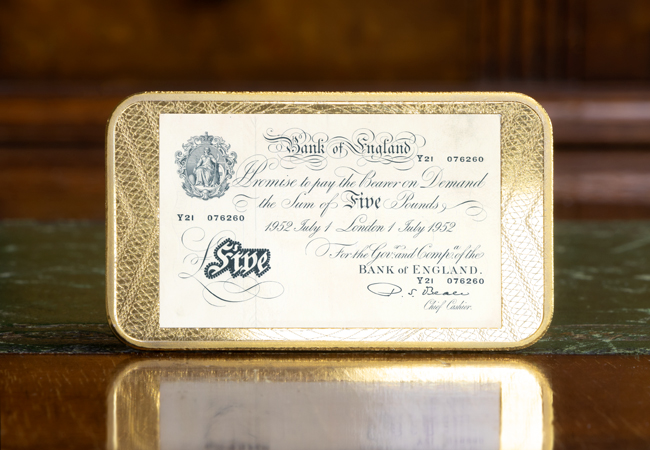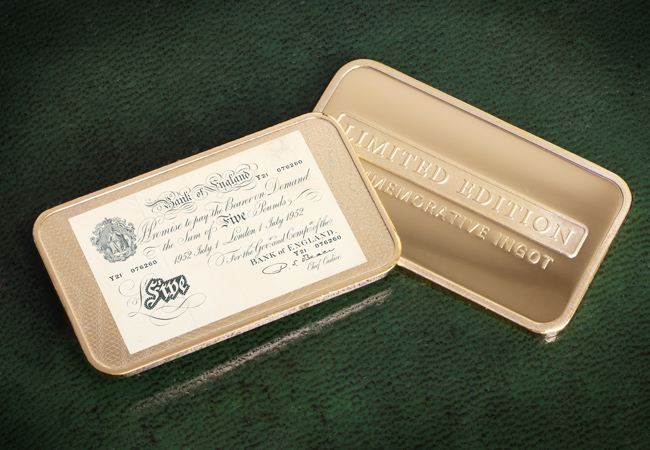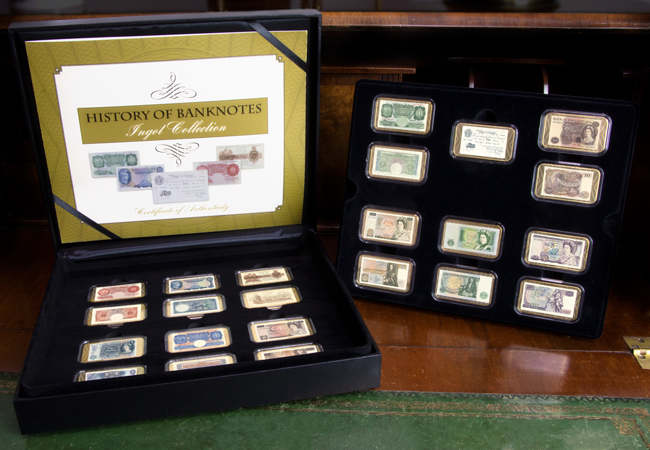Posts Tagged ‘Ingot’
Was this the most famous Banknote ever issued?
First issued by the Bank of England in 1694, Banknotes were originally supposed to be used as a receipt in exchange for gold loans to the bank. Owners of Banknotes could literally take their note to the Bank of England and exchange it for the equivalent price in gold.
In fact, all British notes still have the statement “I promise to pay the bearer on demand the sum of…” to this day.

Britain stopped using the gold standard in 1931, meaning that the right to redeem Banknotes for gold ceased. And by 1945, a metal thread had to be introduced on the £5 note following a security threat from Nazi Germany.
In this blog, we’ll explore the history of the ‘White Fiver’, why an estimated 70,000,000 of these ‘notes’ were burned and the story of one of wartime’s most over-the-top secret plots…
The Story Behind The ‘White Fiver’
The £5 note was only ever intended as a temporary measure, William Pitt, the Prime Minister at the time originally planned to take the £5 out of circulation once economic conditions improved. However, the £5 note has since become the longest serving denomination and at one point was even the highest denomination Bank of England note.
Active between 1793 and 1945, the Bank of England’s White Paper £5 note was the second variant of the denomination and became known as the ‘White Fiver‘. Much bigger than today’s equivalent (which stands at 135 x 70mm), the original paper notes were a huge 195 x 120mm.
But production of these notes was halted during World War II and a new metal thread security feature was introduced to combat counterfeiting attempts from Nazi Germany.

Operation Bernhard
The largest counterfeiting operation in history, Operation Bernhard was the codename of a secret Nazi plot to destabilise the British economy. The Nazis planned to drop counterfeit notes throughout Europe to cause artificial inflation of the British pound.
In 1942, production of counterfeit British ‘White Fivers’ began behind the gates of Sachsenhausen concentration camp. Prisoners worked to perfect the process, revealing over 150 secret security marks, creating identical ink, solving the serial numbering system and printing the notes. By 1945 it is estimated that 70,000,000 notes were printed by inmates – a cache of upwards of £100,000,000.
The plot never came to fruition and at the end of the war Nazis burned huge amounts of British “currency”. But the Bank of England didn’t take any chances and withdrew all circulating notes.
Unsurprisingly Operation Bernhard, as it was known, is remembered as one of wartime’s most over-the-top secret plots.
And that’s why, over 60 years since it was legal tender, the ‘White Fiver’ remains the most famous banknote ever issued…
Your Limited Edition Collecting Opportunity
Today you can own the White Fiver Gold-plated Ingot for FREE (+p&p) when you trial the History of Banknotes Collection.
Your White Fiver Ingot is plated in 24 Carat Gold and struck to a Proof-like finish, framing the famous black and white design superbly.
Just 9,950 of these White Fiver Gold-plated Ingots have been issued for collectors worldwide, a tiny number given the important part the White Fiver has played in British history.
And what’s more, you will gain exclusive access to the History of Banknotes Ingot Collection.
Introductory Offer
The White Fiver is an Introductory Offer for the History of Banknotes Ingot Collection. Each month, you’ll receive two Gold-plated Banknote Ingots for £25.00 (+p&p). Next month, you’ll also receive your FREE Presentation Case to house your collection. You can cancel your subscription at anytime. Click here to secure yours >>


